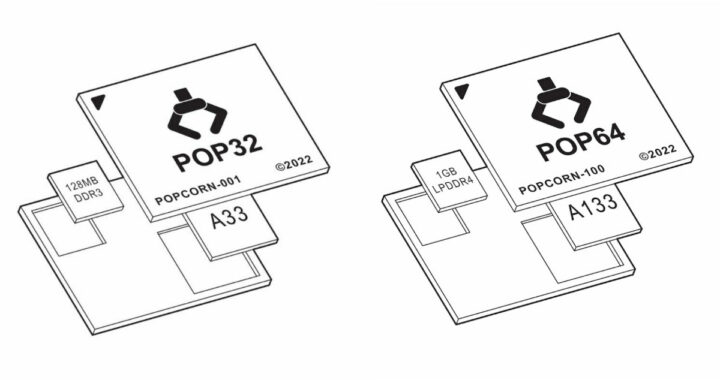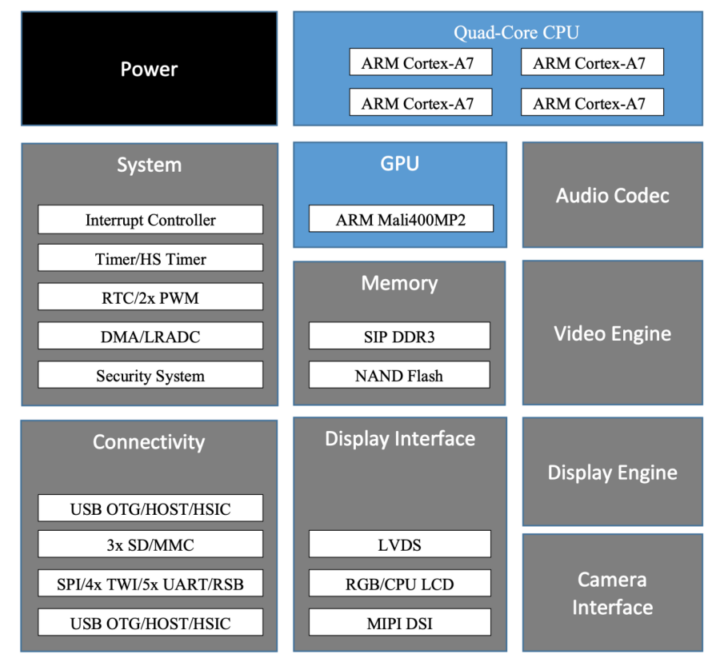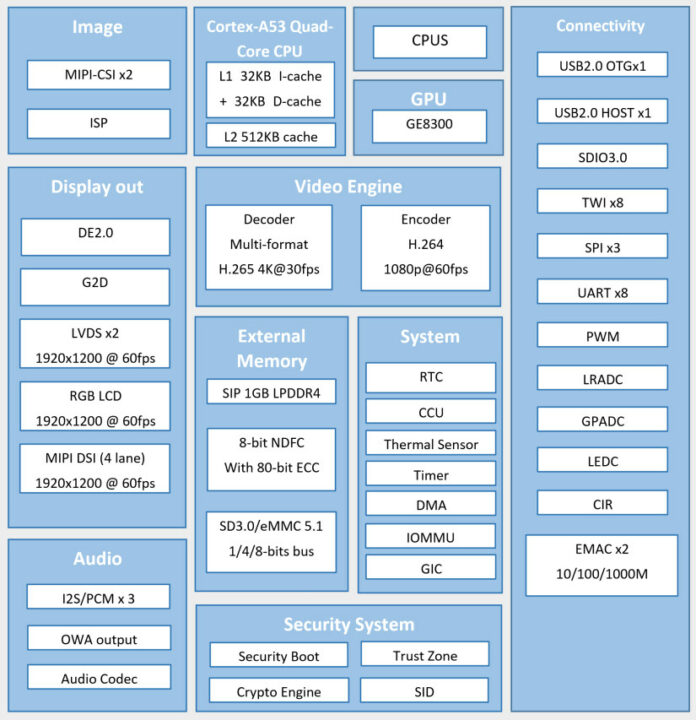Kettlepop is a board based on Allwinner GR8 system-in-package (SiP) with an Allwinner R8/A13 Arm Cortex-A8 CPU and 256MB RAM, and itself a derivative of the CHIP Pro board from Next Thing Co that closed doors a few years ago. Source Parts has just posted an update explaining that the GR8 SiP is not available anymore, so they worked on their own SiPs: POP32 and POP64.
POP32 combines an Allwinner A33 quad-core Cortex-A7 processor with 128MB DDR4, while POP64 features an Allwinner A133 quad-core Cortex-A53 processor with 1GB LPDDR4.
POP32 system-in-package
- SoC – Allwinner A33 quad-core Arm Cortex-A7 processor with Arm Mali-400 MP2, 1080p60 H.264, VP8, MPEG 1/2/4, JPEG/MJPEG video decoding, 1080p60 H.264 video encoding
- Memory – Built-in 128MB DDR3
- Peripherals from SoC
- Storage I/F – NAND flash, 3x SD/MMC
- Display – MIPI DSI, LVDS, RGB LCD up to 1280×800 resolution
- Camera I/F – Parallel camera interface up to 5MP
- USB – USB OTG. USB Host, and HSIC
- Low-speed I/Os – PWM, SPI, 4x TWI (I2C), 5x UART/RSB
- Package – FBGA 262 balls, 0.60mm ball pitch, 16 x 13 x 1.0mm
You’ll find more details in the datasheet. The ancient Allwinner A33 processor was initially designed for Android tablets, but in this case, POP32 would be used with Linux only in the Kettlepop board and maybe others.
POP64 SiP
POP64 specifications:
- SoC – Allwinner A133 quad-core Cortex-A53 processor @ 1.6GHz with PowerVR GE8300 GPU, 4Kp30 H.265, H.264 video decoder, 720p30 VP9 video decoder, 1080p60 H.264 video encoder, MJPEG/JPEG 4Kp15 video encoder
- System Memory – 1GB LPDDR4
- Peripherals from SoC
- Storage I/F – eMMC 5.1, 8-bit parallel NAND Flash, SPI NAND flash
- Display – MIPI-DSI interface, dual-link LVDS interface, RGB interface up to 1920 x 1200
- Camera I/F – 2x MIPI-CSI up to 13M @ 10fps or 8M @ 30fps
- Audio – 3x I2S/PCM. OWA output, audio codec
- Networking – 2x 10/100/1000Mbps EMAC
- USB – USB OTG. USB Host
- Low-speed I/Os – 8x TWI, 8x UART, 3x I2S, 3x SPI, etc.
- Package – TFBGA 318 balls, 0.65 mm ball pitch, 0.35 mm ball size, 18 mm x 16 mm body
Allwinner A133 is also a tablet processor, but being launched more recently, it supports Android 10. I’m not so sure about Linux support. It’s listed on linux-sunxi website as a sun50i variant just like the Allwinner A64 that is well supported in Linux, but it does not have a page on its own. Again Source Parts has released a PDF datasheet for the system-in-package.
Micropop POP32 module
Those package-in-systems will be found in modules provided by Source Parts including Micropop based on the POP32 SiP together with a NAND flash, a wireless module, and a secure element as shown in the video below (renders and PCB layout only).
The company only expects to have inventory 3 to 6 months from now due to the challenging environment in China resulting in long lead times at this time. Eventually, both the SIP and modules will be sold to interested third parties.

Jean-Luc started CNX Software in 2010 as a part-time endeavor, before quitting his job as a software engineering manager, and starting to write daily news, and reviews full time later in 2011.
Support CNX Software! Donate via cryptocurrencies, become a Patron on Patreon, or purchase goods on Amazon or Aliexpress







